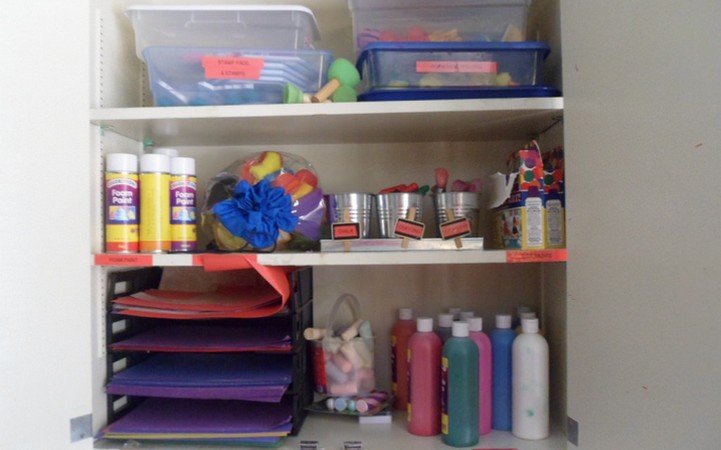
In order for children to create art, they need an inspiring space. The art center should look like an artist’s studio, filled with children’s art as well as that of well-known artists. The art center should allow children to feel creative as they explore materials to express themselves. The art center also allows children to make their own discoveries, either independently or together, and to feel confident in the choices they make.
Setting Up an Art Center in Your Classroom or Family Child Care Home
The location of your art center will depend on the space available in your classroom or home. The following are several different possibilities:
- Near a window: The natural light through the window is pleasant, and children will be able to look outside for inspiration.
- Near a sink: Placing the art center near a sink allows for easy clean-up.
- On a floor that is easily cleaned: Art supplies will inevitably end up on the floor, so a tile floor that can be kept clean or wiped easily is key.
- Outdoors: Most materials used inside can be easily taken outside to continue art activities, and clean-up is often much easier outdoors.
What an Art Center Should Look Like
-
Neat and organized: Children should be able to easily locate the materials. Also, if the center is organized, the expectation is that the children will help keep it that way. This way, there is already a limit in place so they know that part of their responsibility is to clean up after themselves.
-
Well stocked with a variety of materials: Children can easily become bored with using the same materials over and over again. To maintain their interest, the art center should be stocked with many types of materials, varied by size, color, texture, etc.
-
Limitless: With a well-stocked art center and encouragement to be creative, children should have minimal boundaries. Although rules are necessary, children should feel that they can create the art they want with the materials provided.
-
Easy-to-clean furniture: To maintain the life of the furniture, you should plan on having smooth tabletops that are easily wiped clean. If you are unable to use an easy-to-clean table, an alternative is to use a plastic tablecloth that can be wiped clean.
-
Appropriate seating: Both children and adults should feel comfortable in the space. Children also should have the option of standing, so art easels and large painting surfaces should be provided as well. It also is important that adults interact and join in on the creativity, so adult-sized furniture should be available.
-
Art easels: Art is a great way for children to develop their motor skills. While at the table, they are primarily working on fine motor movements, but art easels provide a large area where they can move their arms up and down, working on their gross motor skills. Art easels are also great because they allow children to have a change of scenery so they are not always doing art at the table. Also, art easels can easily be moved outdoors so art can take place in different areas of the classroom.
-
Storage: Some space should be available to children all of the time, while other materials should be kept out of reach.
Choosing Materials for the Art Center
The art center should have many different options for children to choose from. Some examples include:
- paper (manila, construction, newsprint, computer, wallpaper books, magazines, catalogs, used greeting cards, etc.)
- molding materials (modeling compound such as Play-Doh, clay, rolling pins, plastic knives, cookie cutters, shaving cream, etc.)
- paints (tempera, watercolors, finger paints, etc.)
- crayons, markers, pencils, chalk, and erasers
- colored tape
- children’s scissors (left- and right-handed), hole punch
- paste, glue, tape
- paint brushes, sponges
- rubber stamps and ink pads
- collage materials (scraps of fabric, yarn, ribbon, feathers, glitter, buttons, macaroni, any small “beautiful junk” items)
- seasonal leaves, nuts, cones
- recycled materials (yogurt cups, fabric, yarn, tissue paper, foil, bottles)
- miscellaneous items for creativity
Keep in mind that most of these suggestions would be appropriate for a group of preschool-age or school-age children. An art area in a toddler classroom will look very different, because toddlers’ fine motor and cognitive skills are still developing. Be especially cautious about offering materials that are choking hazards to very young children, who may still be likely to place objects in their mouths. Supervise children of all ages when they are using art materials.
For More Information
To read more about learning centers and about art in child care, take a look at the following eXtension Alliance for Better Child Care articles:
- The Art Center in Child Care
- Using Learning Centers in Child Care
- Keys to Planning Successful Learning Centers in Child Care
- Art in Child Care
- Creative Art Activities for Children with Special Needs
Photo by Diane Bales / CC BY http://creativecommons.org/licenses/by/2.0/
